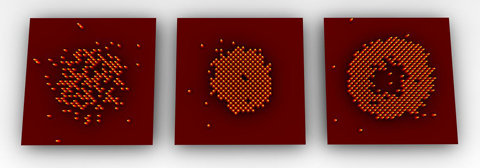Observing Quantum Particles in Perfect Order
Scientists at the Max Planck Institute of Quantum Optics succeed in recording single-atom resolved images of a highly correlated quantum gas.
Ultracold atoms in optical lattices have evolved in the last years into an interdisciplinary tool for many-body solid state and quantum physics. But so far only limited possibilities were available to manipulate and to image the quantum gas on a microscopic scale. For the first time a team around Stefan Kuhr and Immanuel Bloch at MPQ has now succeeded in observing – atom by atom, lattice site by lattice site – such a strongly correlated system (Nature, 18 August 2010, DOI 10.1038/nature09378). The physicists saw that under certain conditions the atoms in the optical lattice arrange in a very regular distribution, with a fixed number of atom per lattice site. This is an important precondition for using these systems as quantum registers with individually addressable quantum bits in future quantum computers.
In their experiment, the physicists deal with a cloud of thousands “bosonic” rubidium atoms. Bosons behave very socially as they aim for the same quantum state at very low temperatures, forming a Bose-Einstein condensate. These ultracold atoms are almost at rest which makes them very sensitive to external light fields. This effect is used to place the atoms in a regular lattice structure. The scientists superimpose crosswise standing laser light waves from different directions, thus creating an optical lattice, a periodic crystal made of dark and bright areas. The resulting light field resembles an egg carton: the dips, which correspond to the bright areas, are energetically favoured. These are the sites where the rubidium atoms like to settle down.
Depending on the lattice height, i.e. the light intensity, correlations between the particles may lead to completely different properties of the whole system. For low intensities the particles are allowed to “tunnel” to their neighbouring sites. The ensemble then represents a superfluid. If, on the other hand, the interactions between the particles dominate at larger lattice depth, the particles are fixed to the lattice sites, and the system evolves into a so-called Mott-insulator (named after the British physicist and Nobel prize winner Sir Neville F. Mott).
According to model calculations, in a BEC the number of atoms varies from lattice site to lattice site, whereas it should approach (for very low temperatures) a constant value in the Mott-insulator case. Now the scientists have been able to directly observe this behaviour experimentally. “We succeeded in imaging single atoms on their individual lattice sites This is a really sensational result”, Dr. Stefan Kuhr, the leader of the project, explains enthusiastically. “As is commonly done we cool the atoms using laser beams. At the same time however we use the fluorescence photons emitted in this process for observing the atoms with a specially developed microscope. This way it was possible to count the atoms on each lattice site. Recording snap shots of atom distributions in the quantum liquid, we were able to detect even single defects and monitor their proliferation when the temperature of the gas was increased.”
Varying particle number and temperature of the quantum gas, the physicists counted the number of atoms per lattice site in a series of systematic measurements. As expected for the BEC the atom density exhibited large number fluctuations. On the other hand, for the Mott insulator an almost perfect structure with a very low defect density was obtained (see images).
The MPQ team even resolved the shell structure which is characteristic of a Mott insulator for large particle numbers (see figure). This structure is caused by the fact that the optical lattice is not flat, but its outer wings point upwards, following the Gaussian profile of the laser intensity. Lattice sites on the outer edge are therefore energetically disfavoured and not occupied before the inner ones have all been taken. From the outside to the inner core the atom number per site increases in a stepwise manner. Pairs of atoms however get immediately lost due to inelastic collisions induced by the irradiated laser beams. Therefore the shell structure appears as alternating bright and dark rings.
A Mott insulator with exactly one atom per lattice site represents a very promising candidate for a quantum register of up to a few hundred atomic quantum bits. “Yet it has to be shown that we are really able to manipulate each individual atom”, Dr. Kuhr explains. “This is a crucial requirement for encoding and reading out quantum bits. We are now at the beginning of setting up the first experiments of that kind.”
Ultracold quantum gases are not only suited for applications in future quantum computers but can also serve as models for condensed matter physics. Here the atoms in the optical lattice play the role of the electrons in the solid state crystal. Investigations along these lines may lead to a deeper understanding of unusual magnetic and electric phenomena, e.g. high-Tc-superconductivity , and may pave the way towards “tailor-made” materials. Olivia Meyer-Streng

Figure caption: In a BEC the atom number density shows large fluctuations from lattice site to lattice site (left). In the Mott insulator state (middle) the atom number is almost perfectly constant. For higher particle numbers the characteristic shell structure evolves (right).
Contact: http://www.quantum-munich.de
Dr. Stefan Kuhr
Max Planck Institute of Quantum Optics
Hans-Kopfermann-Straße 1, 85748 Garching, Germany
Phone: +49 (0)89 / 32905 -738
E-mail: stefan.kuhr@mpq.mpg.de
Prof. Dr. Immanuel Bloch
Chair of Experimental Physics, LMU München
Schellingstr. 4, 80799 Munich, Germany
Direktor at Max Planck Institute of Quantum Optics
Phone: +49 (0)89 / 32905 -138
E-mail: immanuel.bloch@mpq.mpg.de
Dr. Olivia Meyer-Streng
Press & Public Relations
Max Planck Institute of Quantum Optics
Phone: +49 (0)89 / 32905 -213
E-mail: olivia.meyer-streng@mpq.mpg.de
